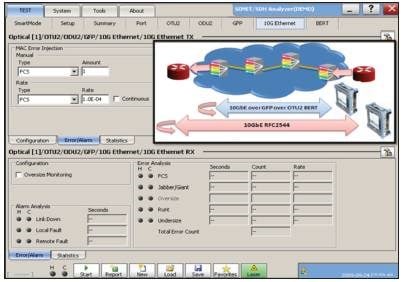Generic Framing Procedure for Mapping 10 GigE LAN PHY over Optical Transport Networks
Traffic growth and continuous expansion of enterprise local area network (LAN) traffic has proven to be a major driver for transporting Ethernet across metropolitan and core optical networks. Employing optical transport network (OTN) as per ITU-T G.709 standard provides a cost-efficient transport layer that supports the dense wavelength division multiplexing (DWDM) transparency while leveraging many SONET/SDH concepts. This allows OTN to serve as a converged transport layer for new packet-based and existing time division multiplexing (TDM) services.
OTN line rates and their corresponding payloads were originally defined to match SONET/SDH signals. Unfortunately, the 10 GigE LAN PHY signal (10.3125 Gbit/s) does not fit into a standard OTU2 signal with its OPU2 (9.995 Gbit/s) payload rate. Using over-clocked OTN rates—OTU1e (11.0491 Gbit/s) and OTU2e (11.0957 Gbit/s)—as per ITU-T Series G, Supplement 43 provides a straightforward solution by simply increasing the OPU2 container rate appropriately. However, the resulting over-clocked rates do not support interfacing with standard OTU2 clients; limiting their deployments to point-to-point type configurations.
Alternatively, a new approach proposed in ITU-T G.7041 generic framing procedure (GFP) (amendment 1) and ITU-T G.709 OTN (amendment 3) retains the benefits of a standard OTN signal, such as frame structure and line speed, while adopting a cost-efficient mapping solution for 10 GigE LAN PHY client signals. This approach takes a 10 GigE LAN PHY signal at 10.3125 Gbit/s rate and intelligently segments it in order to map all of the information into a standard OTU2 (10.7G) signal. In this mapping process, the Ethernet preamble and ordered sets are transported while inter-frame gaps (IFG) and control codes (idle, error and reserved codes) are not.
In addition, mapping the GFP-F frame into OTU2 does not require using the OTN OPU justification control overhead bytes. This frees bytes 1, 2, 3 and 4 of column 16 of the OTN frame in addition to the three reserved bytes in column 15 for a total of seven bytes to extend the OPU payload as shown in figure 1. In this mapping scheme, the payload type (PT) OPU overhead field is set to proprietary (0000 1001) called 64B/66B mapping of GFP-F frames.

Figure 1. Extended OPU2 payload used for mapping 10 GigE LAN PHY
Today, EXFO’s FTB-8130NGE Power Blazer Next-Generation Multiservice Test Module offers a complete suite of capabilities for commissioning, turning-up and qualifying end-to-end 10 GigE services over OTN as shown in figure 2.

Figure 2. 10 GigE over GFP over OTN BER testing using FTB-8130NGE
Running the FTB-8130NGE in SONET/SDH Analyzer (SSA) mode, the user can configure a 10 GigE stream with pseudo-random bit sequence (PRBS) test pattern over GFP and into an OTU2 payload. In this process, the FTB-8130NGE Power Blazer provides full GFP statistics as well as OTN alarms and errors for qualifying the OTN transport layer. The bit-error-rate (BER) test is typically executed over an extended period of time before the customer link turn-up.
Finally, using the FTB-8130NGE Power Blazer in Packet Analyzer mode provides 10 GigE LAN PHY RFC 2544 test for performance availability, transmission delay, link burstability and service integrity measurements, allowing carriers to certify the delivered 10 GigE service through their customers’ service-level agreements (SLAs).
Conclusion
Today, OTN enables the evolutionary next step in 10 GigE LAN PHY deployments while providing optimal utilization of transport capacity. EXFO’s FTB-8130NGE Power Blazer offers a complete suite of testing capabilities for commissioning 10 GigE LAN services over OTN networks and for qualifying end-to-end services, providing a baseline for service providers to define SLAs with their customers.



